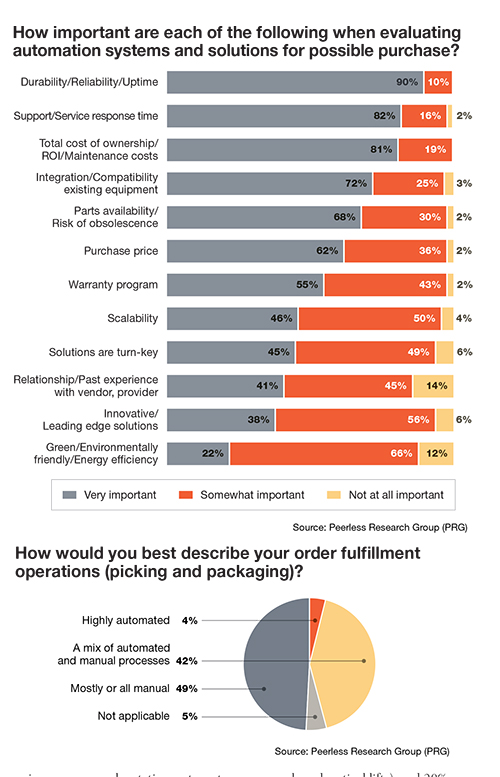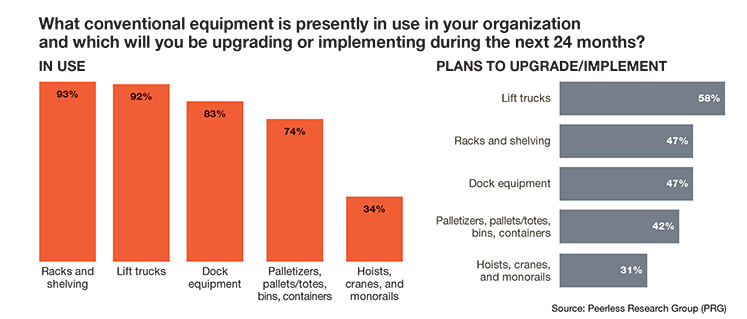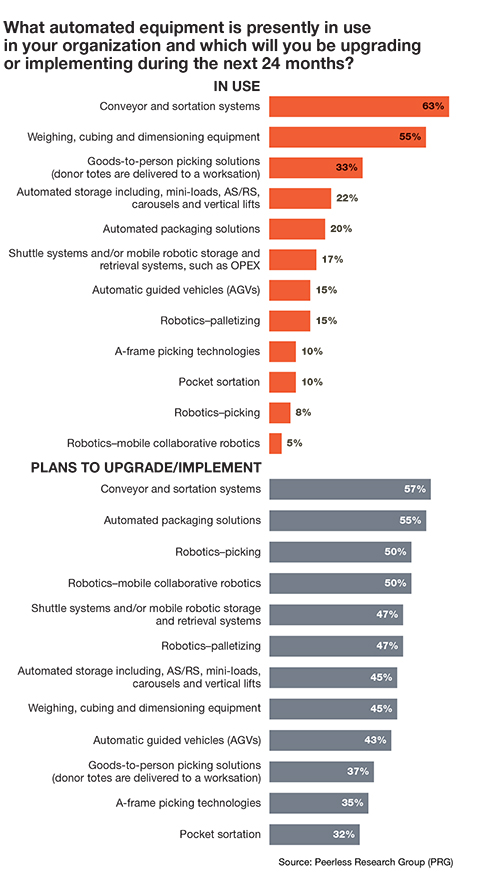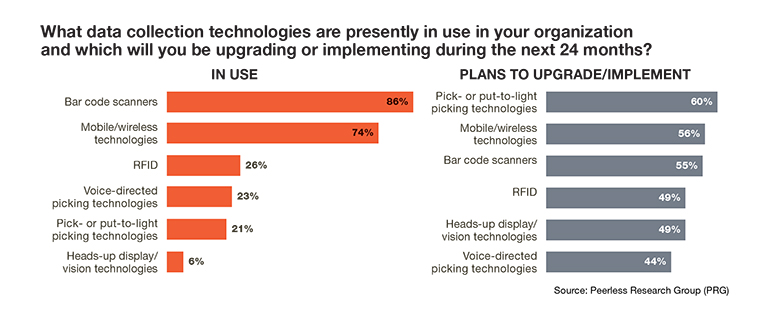As robots, automated equipment, artificial intelligence (AI) and other advanced technologies continue to make their way into the world’s warehouses and DCs, the number of companies using them is also proliferating. Driven by the need to manage high-velocity operations with limited labor resources while meeting the ever-changing needs of their customers, more companies are looking to automation to help them solve their most pressing fulfillment problems.
Modern’s 2019 “Usage and Implementation of Warehouse and DC Automation Solutions” survey more than proves this point and paints a picture of a distribution landscape that’s ripe for innovation. Conducted by Peerless Research Group on behalf of Modern, the survey assessed usage and purchase intentions for automation systems and solutions being used in warehouses and DCs.
When evaluating such systems, companies say their top priorities are durability, reliability and uptime (90%); support/service response time (82%); total cost of ownership (TCO), return on investment (ROI) and maintenance costs (81%); and integration and compatibility with existing equipment (72%). Other key considerations are parts availability, risk of obsolescence, purchase price and warranty program.
Asked about the automation they currently have in place, 42% of respondents have either fully or partially automated conveyance, while 38% have fully or partially done so with their labeling operations. Other functions that have been automated include reporting (57%), replenishment (35%) and packaging (23%). Over the next two years, 61% of companies want to improve their warehouse capacity utilization, 59% their picking efficiency, and 55% are interested in better order accuracy. Other areas ready for improvement include labor reduction, throughput and packaging.
Picking and packaging
 In describing their order fulfillment operations (picking and packaging), survey respondents say 49% of those activities are mostly or completely manual, while 42% use a mix of automated and manual processes. Just 4% of companies consider their fulfillment operations to be “highly automated.”
In describing their order fulfillment operations (picking and packaging), survey respondents say 49% of those activities are mostly or completely manual, while 42% use a mix of automated and manual processes. Just 4% of companies consider their fulfillment operations to be “highly automated.”
The highest percentage of order fulfillment activities (79%) are used for warehousing and storage, with 58% being used for individual picking, packing and shipping in wholesale distribution fulfillment. When asked which order fulfillment activities they’d like to enhance over the next two years, companies point to full and mixed pallet load fulfillment (59%); individual picking, packing and shipping in wholesale distribution fulfillment (57%); and case and mixed-use fulfillment (57%).
Of the conventional equipment currently in use, 93% of companies use racks and shelving; 92% rely on lift trucks; 83% use dock equipment; and 74% rely on palletizers, pallets/totes, bins and containers. According to Modern’s survey, companies plan to upgrade existing or implement new lift trucks (58%); racks and shelving (47%); and dock equipment (47%) over the next 24 months.
Right now, 63% of companies are using conveyor and sortation systems to automate their facilities, while 55% rely on weighing, cubing and dimensioning equipment. Thirty-three percent use goods-to-person picking solutions (i.e., donor totes delivered to workstations); 22% use automated storage (mini-loads, automated storage and retrieval systems, carousels and vertical lifts); and 20% rely on automated packaging solutions.

Over the next 24 months, 57% of companies plan to shop around for conveyor and sortation systems, while 55% want automated packaging solutions and 50% will invest in robotics for picking. Fifty-percent are interested in mobile collaborative robots, 47% in shuttle systems/mobile robotic storage, and 47% in robotics that are used for palletizing.
Choosing wisely
Of the companies that are planning to evaluate or buy automated materials handling equipment, technology or software in the next two years, most are looking to fill orders faster to meet customer service level agreements and expectations. Other investments are being driven by faster e-commerce order piece picking and packing, and some companies see automated options as a way to deal with the persistent labor shortage.
Bryan Jensen, chairman and executive vice president at St. Onge Co., says he’s also seeing healthy levels of interest in warehouse automation right now, with the tight labor market as a key driver. “If you’re in a distribution operation that is level-loaded and doesn’t have large seasonal, inter-week, inter-month or inter-quarter peaks, automation can be very effective in justifying itself through labor reduction,” says Jenson. “The more expensive labor gets relative to automation’s prices not going up, the more effective that automation is at reducing labor and paying for itself.”
The rules shift somewhat for operations that have to manage high seasonal peaks and other significant order volume fluctuations. A company whose peak week experiences eight times the volume of its average week, for example, may need eight times the automation investment. A firm that usually has 100 full-time equivalents working in the DC year-round, for example, could need up to 800 to effectively manage those peaks—but only for a very short period every December. “If that company buys automated equipment to supplant half of that 800-person workforce,” Jensen points out, “it’s going to be far too expensive and won’t pay back.”
To help companies overcome this issue, some automation and robotics makers could offer leasing options similar to those traditionally used by forklift suppliers. This finds the robotics manufacturers keeping a bevy of robots on-hand and ready to lease as needed, and for a price that’s lower than the equipment’s purchase price. This also benefits the robot manufacturer, which can lease the equipment out multiple times “and make significantly more than if it just sold them,” says Jensen.
Data collection, execution & management
 Data collection technologies continue to hold an important place in today’s warehouses, where 86% of companies are using bar code scanners, 74% rely on mobile/wireless technologies, and 26% use RFID. Twenty-three percent of firms use voice-directed and 21% rely on pick- or put-to-light picking technologies. The highest percentage (60%) of companies plan to upgrade or implement pick- or put-to-light picking technologies over the next two years, followed by mobile/wireless (56%), bar code (55%), RFID (49%) or heads-up display/vision technologies (49%)
Data collection technologies continue to hold an important place in today’s warehouses, where 86% of companies are using bar code scanners, 74% rely on mobile/wireless technologies, and 26% use RFID. Twenty-three percent of firms use voice-directed and 21% rely on pick- or put-to-light picking technologies. The highest percentage (60%) of companies plan to upgrade or implement pick- or put-to-light picking technologies over the next two years, followed by mobile/wireless (56%), bar code (55%), RFID (49%) or heads-up display/vision technologies (49%)
When asked about the supply chain execution (SCE) systems they currently have in place, 80% of respondents are using warehouse management systems (WMS), 38% use transportation management systems (TMS), 33% have implemented labor management systems (LMS), and an equal percentage rely on warehouse control software (WCS). Other types of SCE software currently in use include computerized maintenance management systems (CMMS), slotting software and yard management systems (YMS).
The companies that want to upgrade existing or implement new SCE software in the next two years have their sights set on WMS (56%), WCS (43%), YMS (43%), TMS (41%) and warehouse execution systems (41%).
On the supply chain management (SCM) side of the software equation, the biggest percentage of companies (52%) are currently using enterprise resource planning (ERP) systems, while 51% are using customer relationship management (CRM) and 47% rely on order management systems (OMS). Other SCM solutions in use are network design and optimization software (24%); distributed order management (24%); and supply chain planning (22%).
Respondents who want to upgrade existing or implement new SCM software in the next two years are considering ERP (64%), supply chain planning (48%), network design and optimization software (48%), OMS (42%) and CRM (35%).
When procuring replacement or spare parts for their equipment, the majority of companies (73%) buy direct from the manufacturer or from its Website. Sixty-two percent of firms get the parts from a distributor and 28% buy direct from a systems integrator. To handle the repair and maintenance of the automated materials handling equipment, 66% of companies rely on an internal maintenance crew, 41% have service contracts with their OEMs, and 34% set up service contracts with third parties.
What are they spending?
In 2019, most companies will spend either $100,000 to $499,999 or $1 million to $2.49 million on materials handling equipment and solutions (an equal 20% of readers replied for each of these two categories). Twelve-percent of firms plan to spend more than $5 million, while 32% expect to allocate less than $100,000 for such solutions. Looking ahead to 2020, respondents said their investments will either stay the same (40%) or increase (33%).

When purchasing order fulfillment solutions, 71% of companies buy directly from the manufacturer of those solutions while 70% get them from distributor/dealers. Another 44% work with systems integrators that manage the acquisition process and the integration. Asked about future purchases, 60% plan to go direct, 55% will work with an integrator and 42% will buy from a distributor/dealer.
To companies that are evaluating warehouse automation, Jensen says to look for solutions that are proven within those firms’ specific business profiles. “Every operation is unique,” he points out. “The needs of a direct-to-consumer grocery operation are going to be very different from the needs of an apparel operation, particularly around the warehousing environment itself, the number of SKUs, and the number of lines per order. These should all be factored into the decision-making process.”
About the survey participants
Thirty-three percent of this year’s survey respondents are running warehouses that are more than 250,000 square feet, while the average facility size across all respondents was 148,375 square feet. These facilities either serve as warehouses or DCs (36%), corporate headquarters (32%) or manufacturing plants (19%). Each of these facilities has an average of 612 employees, with the majority of respondents (51%) working for companies that have less than 100 workers.
The average annual revenues for these firms was $917 million, with 28% working for firms with less than $10 million in revenues and 10% at companies with more than $5 billion in revenues.
The top manufacturing industries represented included food, beverage, and tobacco; industrial machinery; textiles and apparel; paper/printing; computers and electronics; and plastics and rubber (among others). On the non-manufacturing side, respondents work for business/consulting services, retail, wholesale, and third-party logistics providers (3PLs).
About the Author
Follow Robotics 24/7 on Linkedin
About the Author
Follow Robotics 24/7 on Linkedin
Article topics
Email Sign Up
















